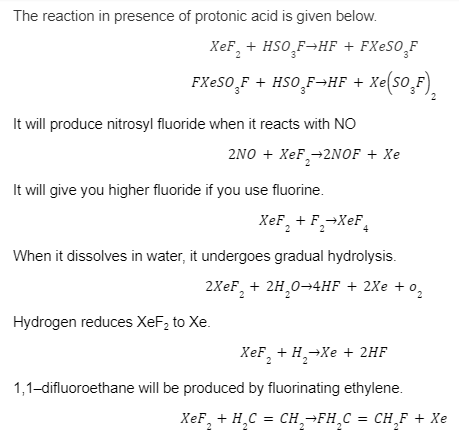In 1904, Sir William Ramsay was awarded the Nobel Prize in Chemistry for his discovery of “Noble Gasses.” These are sometimes known as inert gasses since they do not easily react or rarely react. Xenon is an inert gas that rarely forms compounds with other elements due to its stable electronic configuration. Although, when compared to other inert gasses, it is more reactive and forms connections with other elements due to its enormous size.
Xenon difluoride is a xenon-fluorine compound. One xenon atom and two fluorine atoms make up this powerful fluorinating agent. It’s one of the most stable forms of xenon. It’s a crystalline solid with a rich white color. It was probably 1st Rudolf Hoppe, a German chemist, who invented it in early 1962. In an electrical discharge, he mixed fluorine and xenon to make it. Chernick, et al. released the first published report on xenon difluoride in October 1962.
XENON FLUORIDE:
The chemical compound Xenon Difluoride (XeF2) has the formula XeF2. In 1962, it was discovered. It’s a strong fluoridation agent. In addition reactions to a double bond, XeF2 was thought to be a viable convenient alternative for elemental fluorine. In Xenon Difluoride, the oxidation state of xenon is +2. The vapor pressure of xenon tetrafluoride is minimal at -78° and roughly 3 mm-Hg at ambient temperature. Xenon difluoride is a dangerous chemical that forms hydrofluoric acid when it reacts with moisture.
SYNTHESIS:
The reaction of xenon and fluorine gases in the presence of heat, irradiation, or an electrical discharge produces it. As a result, the xenon difluoride obtained is solid. Fractional distillation or selective condensation with a vacuum duct are used to purify it. Dioxygen difluoride can also be used to make it.
Xe + O2F2 → XeF2 + O2
XeF2 is generated when a 2:1 mixture of xenon and fluorine is heated at 400OC in a sealed nickel tank.
Xe + F2 → XeF2
XENON DIFLUORIDE STRUCTURE:
One xenon atom and two fluorine atoms form two covalent bonds in the XeF2 structure. Three lone pairs of electrons are likewise held by the xenon atom. Xenon difluoride is a linear molecule with a wavelength of 197 pm in the vapour phase and 200 pm in the solid phase.
When we look at its solid structure, we can see that the fluorine atom will avoid the equatorial region, and that this molecule will have three pairs of unpaired electrons surrounding the equatorial region of the xenon atom, according to VSEPR theory.
XeF2 can be changed to XeF4 under a pressure of 50 Gpa, and it’s important to remember that XeF4 is a semiconductor. XeF4 will have the same structure as graphite. If we boost the pressure above 90 Gpa, xenon difluoride will transform into a metallic 3d complex. For example , XeF8
The Xe—F bonds in the XeF molecule are weak. The total bond energy of the XeF2the molecule is 267.8 kJ/mol.
The first bond energy is 184.1 kJ/mol, and the second bond energy is 83.68 kJ/mol.
One thing to keep in mind is that XeF2is more stable than KrF2 due to its lower bond energy (92.05 kJ/mol).
MOLECULAR WEIGHT OF XENON:
The molar mass or molecular weight of a xenon atom is 131.293 u (xenon is an ideal gas).
OXIDATION NUMBER OF XeF2:
Oxidation state of xenon in XeF2 is +2.
PROPERTIES:
BrF5, BrF3, anhydrous hydrogen fluoride, methyl cyanide, and IF5 are all solvents that XeF2 is soluble in. 169.290 g.mol-1 is its molar mass.
It is the xenon compound that is the most stable. It is sensitive to dampness. When it comes into touch with moisture, it produces hazardous chemicals. When it comes into touch with light or water vapour, it decomposes.
It’s a crystalline solid that’s thick and white in colour. It has a foul odour and has a low vapour pressure. It has a melting point of 128.6 degrees Celsius. Exposed tissues are corroded by it. It has a linear shape. It is water soluble. At 0°C, solubility in water is 25g/L.
The xe-F bond length in solid xenon difluoride is 200 picometres, while it is 197.73 picometres in the vapour state.
CHEMICAL PROPERTIES OF XENON DIFLUORIDE:
When xenon difluoride reacts with a strong protonic acid like perchloric acid, it produces a substitution process.

USES OF XENON DIFLUORIDE:
A. Used to oxidize and fluorinate the hetero element in an organometallic compound, but does not attack the alkyl or aryl groups
B. Used as a very convenient for the detection and determination of very small amounts of iodine and iodide based on the oxidation of iodine to periodate.
C. Used to kill bacteria, power lasers and tracers as an antiseptic. It is preferred to power spacecraft in deep space as fuel for ion engines.
CONCLUSION:
Xenon difluoride is a xenon-fluorine compound. One xenon atom and two fluorine atoms make up this powerful fluorinating agent. It’s one of the most stable forms of xenon. It’s a crystalline solid with a rich white color. In this chapter we have discussed Xenon fluoride, its structure, synthesis, properties and its uses.
 Profile
Profile Settings
Settings Refer your friends
Refer your friends Sign out
Sign out






